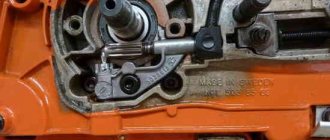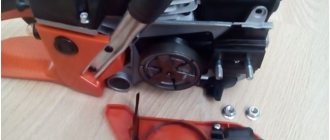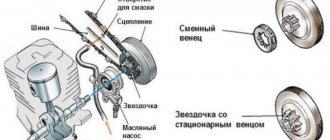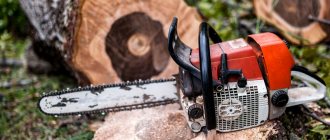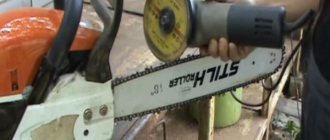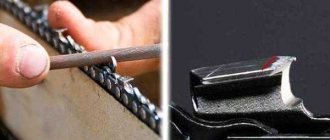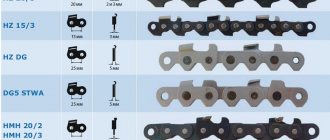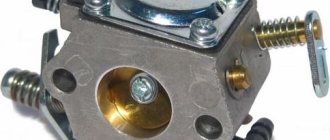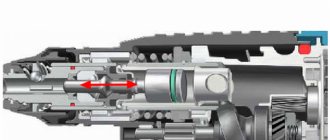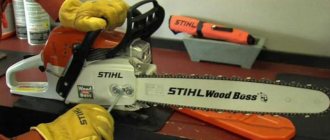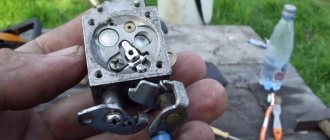When buying a chainsaw, be prepared for the fact that you will have to master not only the skill of sawing logs and felling trees, but also repairing the tool. Having studied the instructions without fail, check the correct operation, in other words, test the tool. It’s good if the work goes smoothly and smoothly, however, it may be that the saw moves to the sides, or it refuses to cut the log altogether. The first thing experienced professionals always pay attention to is the chain tension on the chainsaw.
Why does the chain fall off?
These problems apply to both gasoline and electric saws. If a chain breaks during operation, there are several reasons why this happens:
- Tire problems;
- Chain stretching;
- Problems with the drive sprocket.
Let's take a closer look at them.
Bus problems
If you find that the chain is falling off due to problems with the tire, then the reason must be looked for in the place where it is attached. The groove is located between a plate on the chain set and another plate on the body itself. The bolt attachment is called a motor assembly. In all models of chainsaws, the mounting point for the bar is hidden under the plates. Over time, the bolts become loose and do not hold as tightly, so tire vibration increases.
Saw bar device
If, during a visual inspection, you determine that the chain tension is good, the operation of the saw is also satisfactory, and the bar is loose, then it should be secured and tested.
Chain stretch
Over time, it becomes noticeable that the chain begins to sag. Like every tool or spare part, the chain has its own service life, after which it must be inspected and possibly repaired. Since it is the chain that is subject to the greatest loads, it can not only stretch, but also become dull. You need to shorten the saw if you have already unscrewed the adjusting screw all the way. Usually no more than 1 or 2 links are removed.
Stretching occurs for the following reasons:
- Malfunctions have occurred in the oil pump due to a disruption in the oil supply or its complete absence. When heated, the chain is subject to greater stretching.
- Unfavorable working conditions. Dust, dirt and sawdust get on the saw set, contaminating it and acting as an abrasive. Over time, the attachment points of the links wear out and the chain stretches.
- If low-quality oil is poured in to lubricate the chain or waste from the machine’s engine, then the particles that are present there also act as an abrasive.
- Over time, the chain stretches naturally.
How to tighten: installing a chainsaw cutting element
We have discussed the main reasons for a sagging chain. How to install a chain on a chainsaw is described in the paragraph above. Now you need to properly tension the chain and check if it is too tight.
Chain tension
There are two ways to tighten the chains: fast and frontal. It is best to do the tension in the frontal way.
If you carry out front tensioning, you need to unscrew the nuts that hold the tire and lift it by the edge. Using a special bolt located on the right, you need to tighten the chain until an acceptable tension is obtained, and then raise the tire even higher and clamp it.
Important! It is worth remembering that you can only tighten the cold chain. If you pull on an overheated chain after work, then after cooling it can burst and damage the tire (according to the laws of physics, hot metal always expands).
If you use the quick tightening method, you first need to lift the wing nut handle and loosen it. Then tighten the chain tension screw clockwise until it stops. Then tighten the wing nut again and lower the handle.
Tension check
To check the chain tension, you need to disable the saw's brake system. Then manually move the chain along the tire, if it moves smoothly and does not sag, then everything is fine. If the chain moves very tightly, then it needs to be loosened a little, because there is a risk of breaking during operation.
To facilitate manual labor in the garden, many gardeners use a walk-behind tractor or a mini-tractor.
Tools you will need to tension the saw
First of all, you need a basic knowledge of working with mechanisms. In general, it all depends on the type of saw you use. For example, in Stihl, tensioning is very simple. There is a built-in tensioner. The following list of actions will help you do everything right:
- The sprocket cover is removed using a wing nut;
- By rotating the adjustment wheel, the sufficient tension is determined independently;
- The lid closes and the chain is secured to the bar.
Chainsaw chain tensioner
If a chainsaw, such as Sparky, does not have a tensioning mechanism, then you must perform the following steps:
- Unscrew the screws using a hexagon and remove the housing;
- Unscrew the screw and remove the nut;
- Using a disc, grind the part of the screw that is adjacent to the saw body;
- Reassemble the saw in reverse order;
- Clean sawdust from sawdust.
Tensioner device and operating principle
To tension the chain on a chainsaw, there is a special device. The complexity of the mechanism design is determined by the cost of the instrument and its budget category. In inexpensive models, the chain tensioner for a chainsaw is a bolt with a regulator located on the side.
Adjustments can be made using a screwdriver or a special tool. The tightening key is included in the kit for operation. It consists of 2 parts: on one side there is a device for unscrewing the nuts, on the other there is a slotted screwdriver. More expensive models are represented by an adjusting tool such as a lever or an adjusting disk.
How to put a chain on a saw?
In order to simplify the procedure of putting the chain on the saw, you need to use an installation wheel. Next, dress according to plan:
- The surface on which the saw is installed must be level;
- Remove the sprocket protection from the chainsaw;
- Turn the tension sprocket to the right until it stops;
- Place the chain on the fixing part. Be sure to follow safety precautions so as not to get hurt while performing actions;
- Place both elements on the star;
- Reattach the cover;
- Make sure that the guides are in the right places;
- Check the condition of the circuit.
Step-by-step installation algorithm
Not all modern chainsaws are equipped with an installation wheel, which significantly simplifies the procedure for installing the saw blade. Systems with an adjustment wheel are generally rare among household chainsaws.
Therefore, it is very important to know the technology and sequence of installing a chain on a chainsaw
Key points to note:
- Prepare a flat surface on which you will assemble the chain and bar. This will minimize the chance of damage to the chainsaw or loss of small parts. A tire is laid out on the prepared surface and a chain next to it in parallel.
- Remove the sprocket guard, on modern chainsaws it is enough to unscrew the wing nut, on older models you may need a spanner of the appropriate size.
- At the base of the guide bar, turn the tension sprocket all the way to the right. Only in this position is the chain installed.
- Then the chain is placed sequentially, link by link, onto the locking groove on the guide bar. Install the chain from the top of the guide, gradually turn it so that the bar is always on top and the chain is on the bottom, this will allow it to always be taut and fit into the guide groove without problems. When performing this step, be sure to wear thick protective gloves, because your fingers will touch the cutting edge. If you look from above, the cutter is always located forward towards the end of the guide bar.
- Place both the bar and chain on the drive sprocket.
- Secure the chain sprocket cover in place. Make sure all mounting pins line up with the holes. Incorrect installation with distortions or not completely can cause extraneous noise and rattling.
- Make sure that the guides fit into the special mounting groove.
- After installation, check that the chain is secure on the chainsaw and on the bar. Everything should be securely fastened without any backlash.
An important point is the degree of chain tension after installation. Setting the correct tension is very simple and takes no more than three minutes. First you need to loosen the nuts on the protective cover. Using a freely rotating adjusting screw, set the correct tension so that the chain does not pull more than 3-5 mm from the edge of the guide bar.
All that remains is to tighten the nuts and check the tension. If adjustment is necessary, adjust the tension again.
How to install a bar and chain on a chainsaw, see the following video, which presents a clear algorithm of actions:
Ways to check the degree of tension
Checking the tension level is important, as the consequences of incorrect adjustment can be fatal for the sawyer. The quality of chain tension adjustment can be determined by:
- When moving the product manually, it should not jam or show signs of difficulty in its movement.
- The cutting element must be checked for looseness by grasping the link and trying to pull it up. The normal tension value should correspond to the exit of the shanks from the tire (in its middle) of no more than 2/3.
- When moving the device, there should be no creaks or other extraneous noise.
In conclusion, it should be noted that you should never adjust the chain while it is hot, as this will certainly lead to a number of negative consequences. As a result of such actions, it may be necessary to replace not only the tire and chain, but also the drive sprocket.
How to measure chain size?
To determine the size of the chain, there are three parameters: pitch, length, thickness. To measure the length of a chain, you need to count the number of teeth in it.
The pitch is the length between three adjacent rivets.
The table below shows the correspondence between the distance between the rivets and the chain pitch:
Another important parameter is the length of the shank. The table below shows the shank thickness dimensions:
The most common pitch is 0.325 inches long. It is suitable for household saws with power up to 2500 W. Usually, the length of the saw is indicated in the passport and there is no need to measure it.
Tools required for work
When starting riveting, the first thing you need to do is remove the link from the chain; for this you will need to rivet the rivets. For riveting, you will need an anvil, a hammer, a thin bit, a vice, a grinder with a grinding wheel or emery cloth. These tools do not allow for quality work, but everyone has them. A more cultured and gentle way is to remove the rivets using a special punch.
There are several designs of punches; we’ll tell you about the most popular.
Rivet punch
A punch is a machine that is used to remove rivets.
It is mechanical and works on the principle of a press. The kit includes a special anvil, in which grooves are selected for installing the headset with different pitches. There are also replaceable tips with which the rivets are extruded.
Important: the size of the rivets in different types of chains is different, so when buying a punching machine, make sure that the kit includes several tips that are used for different types of fittings.
We invite you to watch a video that shows how to rivet a saw chain using a mechanical punch.
After the chain is riveted, it is necessary to remove the old link, install a new one and rivet it. For this purpose, a riveting-rolling machine is used. It is electric, so it costs much more than a punching machine.
Riveting and rolling machine
The machine is equipped with a gear motor with high torque.
Used for riveting and rolling headsets in increments from 1/4″ to 0.404″. The cutting depth of chains that can be riveted using this machine is from 1.1 mm to 2 mm (0.043″ - 0.080″). Special rotating inserts and anvils for different types are supplied with the machine. Inserts and anvils are marked. Marking “A” means that the inserts are designed for a headset with a pitch of 3/8″ and 0.404″. “B” is for 1/4″ and 0.325″.
The machine works as follows. The saw chain with a new link and rivets is installed in the guide inserts. The repair link with the rivets installed in it is pressed by the working roller against the anvil, after which the engine is turned on and the roller begins to rotate, gradually crushing the rivet, at this moment the machine operator slightly increases the pressing force of the roller by tightening the adjusting screw. For clarity, we suggest watching a video about the operation of a riveting-rolling machine.
It is not profitable to use such a machine for riveting houses, because it is expensive. If you do not need to rivet regularly, you can do without it. Let's look at how to shorten a chainsaw chain with your own hands without using expensive machines. You need to start by riveting and removing the link.
The advantage of the machine is that the rivets riveted with its help are practically no different in quality from those riveted in the factory.
Principle of chain tensioning
The chain tension is carried out according to the following steps:
- Loosen the nuts on the housing cover;
- Tension the chain by rotating a screwdriver in a special groove;
- The tension must be controlled manually slowly and carefully;
- After tensioning the chain, replace the cover.
If you used a carbide or pobedit chain, then it is better to contact a specialist to sharpen it, since it is almost impossible to sharpen a pobedit and carbide chain at home.
Consequences of poor quality repairs
The consequences of poor-quality repairs can be very sad; the chain at the moment of rupture can injure the operator. Of course, modern saws are equipped with all kinds of protection. For example, catchers are installed on them, which are designed to protect the operator in an emergency, and the right hand, which is on the chain line, is hidden behind the body.
But the protection does not provide a 100% guarantee, therefore, before using the repair chain with maximum load, you need to test it on light work, sawing a couple of branches or boards.
Also, the consequences of poor-quality repairs can affect the performance of the chainsaw. Let's look at what mistakes can be made during repairs and how they will affect the operation of the saw.
Errors when repairing circuits
- The step does not match. The reason is that the installed working link is not suitable for the main parameters: pitch, link thickness. If such a headset is used for work, then as a result you will need to replace the drive sprocket and saw bar, since the sprocket on the bar will break.
- Another option for a mismatch in pitch is to install the working tooth in the opposite direction. It is extremely rare, but it still happens, especially among those who are repairing for the first time. The consequences are similar to the first point.
- The chain is longer than the bar. With this everything is clear, the adjusting screw will not be enough for tension, the chain will dangle and wear on the drive sprocket will increase.
- Briefly speaking. Such a headset cannot be installed; it will need to be riveted and extended.
- The connecting link is slightly longer. Similar to the first point, the pitch will change, which will lead to the destruction of the driving and driven sprocket.
In conclusion, I would like to pay special attention to the quality of articles on this topic. On the pages of websites on the Internet there is information on how to repair a saw chain using welding. Such instructions are written by incompetent authors who themselves do not understand what they are writing about.
Repairs can be made by welding, but these are not saw chains, but gear chains designed to transfer force from one sprocket to another.
These can be found in the mechanisms of agricultural machines, conveyors and other units.
Chainsaw Partner 401 – tool capabilities
This chainsaw from Partner can be used in a variety of areas, from gardening to logging. A powerful engine with a solid reserve of torque increases the endurance of the tool when working in difficult conditions.
The basic package includes a standard gasoline engine with a power of 1700 watts. The engine is complemented by an effective vibration suppression system and a modified muffler, which reduces the noise level when the saw is operating. All saw malfunctions can be easily eliminated thanks to free access to its working mechanisms.
Model specifications include:
- The power of the standard internal combustion engine is 2.3 liters. With.;
- tank for filling with fuel mixture – 400 ml:
- possible length of the tire used for work is 35–40 cm;
- standard working chain pitch – 3/8 “;
- weight including headset – 5 kg.
The tool is supplied with a container for preparing fuel, a set of keys for maintenance and instructions.
When to shorten or stretch a chain
What to do when the chain needs to be shortened or stretched, when links need to be added or removed?
First, let's figure out in what cases it is necessary to shorten the chain, that is, remove links from it.
The chain is shortened:
- if turning the adjusting screw is no longer enough to tighten it;
- if a tire of shorter length than the standard one was installed.
Accordingly, you can make the chain longer if:
- a longer bar will be installed on the saw;
- Some links are so worn that they need to be completely removed, which means the chain will become shorter and need to be lengthened to its original size.
As a rule, one or two links are removed. To reduce or increase the size of the chain, you will need the following tools:
- a machine for removing rivets - a punch (a mechanical device that works on the principle of a press, is equipped with tips for squeezing out rivets and replaceable grooves for different chain pitches);
- riveting and rolling machine (designed for chains with pitches from 1/4″ to 0.404″).
Video about the operating principle of the Oregon riveting machine:
Video about the operation of the Oregon rivet machine
Chainsaw Partner 340 – advantages of the model
The Partner P340C chainsaw is equipped with a 2-stroke engine with a volume of 35 cm3. The carburetor is equipped with a manual fuel pump, which simplifies starting a cold engine. For operator safety, the saw is equipped with an inertia chain brake, which can be activated in two ways.
Features of this Partner model include:
- The power of the standard internal combustion engine is 1.95 liters. With.;
- tank for filling with fuel mixture – 250 ml;
- possible length of the tire used for work is 30–35 cm;
- standard working chain pitch – 3/8 “;
- weight including saw set – 4.7 kg.
Free access to the working mechanisms of the model simplifies its maintenance and DIY repairs.
Chainsaw Partner P360S – tool description
Chainsaw Partner P360S stands out for its efficiency. Fuel consumption does not increase even with increasing engine loads. This feature makes the model indispensable on farms where a large amount of work needs to be done.
Tool features include:
- The power of the standard internal combustion engine is 2.04 liters. With.;
- tank for filling with fuel mixture – 250 ml;
- possible length of the tire used for work is 40–45 cm;
- standard working chain pitch – 3/8 “;
- weight including saw set – 5 kg.
Free access to the main consumable parts of the model simplifies its independent repair. The operator has the opportunity to replace filters and other spare parts without having to disassemble the tool.
Operating a chainsaw
The cause of frequent malfunctions is that the fuel mixture entering the cylinder is too rich or lean.
According to the operating instructions, the chainsaw is fueled with gasoline of at least AI-92 grade. The oil is chosen for 2-stroke power plants. The optimal proportion is 50:1, i.e. 1 liter of gasoline is diluted with 20 ml of motor oil.
In the absence of qualified maintenance, improper operation, or use of the saw for purposes other than its intended purpose, various damage may occur.
The main malfunctions of the Partner gasoline saw:
- The engine does not start - check the ignition system.
- The tool starts, but when you press the gas it stalls - the clutch is being repaired.
- The engine does not develop full power - the carburetor is being repaired.
- The saw chain does not spin - change the oil pump.
- If excess soot is formed, adjust the carburetor.
Chainsaw Partner 352 – tool parameters
The model is equipped with a simple but quite reliable gasoline engine. The capacity of the working cylinder is 39 cm3. The walls of the latter are made of hardened steel and covered with a protective chrome layer.
Specifications for this Partner model include:
- The power of the standard internal combustion engine is 2.2 liters. With.;
- tank for filling with fuel mixture – 380 ml;
- possible length of the tire used for work is 30–35 cm;
- standard working chain pitch – 3/8 “;
- weight including saw set – 4.9 kg.
This tool stands out for its ease of use. It copes with high loads when working in hot weather without increasing the amount of fuel consumed.
Tire maintenance and operation
An important part in the sawing apparatus of a chainsaw is the tire. The performance and quality of the device largely depends on its serviceability.
Saw chain lubrication system
Premature tire wear most often occurs due to improper operation of the automatic lubrication system. Strong friction occurs in the saw zone, which leads to heating and deformation of the metal. As a rule, the driven sprocket fails first. Also, to prevent premature wear, it is important to turn the tire over more often - this helps to wear the driven sprocket rollers evenly.
Important: Use a bar with the specifications specified by your chainsaw manufacturer. This will extend the service life of both the saw set itself and the entire gas or electric saw.
Main tire faults:
- Deformation or damage to the tire body;
- Abrasion of teeth or complete breakage of the driven sprocket;
- Wear of the landing groove and shank;
- Critical damage to oil supply channels;
- Breakage or complete wear of the tensioner;
Chainsaw Partner 421 – tool kit
The standard configuration of the saw includes a gasoline 2-stroke internal combustion engine. It is complemented by an effective vibration damping system, which greatly simplifies working with the saw at heights and on fragile surfaces.
Tool features include:
- The power of the standard internal combustion engine is 2.5 liters. With.;
- tank for filling with fuel mixture – 550 ml;
- possible length of the tire used for work is 40–45 cm;
- standard working chain pitch – 3/8 “;
- weight including headset – 4.9 kg.
This Partner tool is equipped with a double air purification system, which significantly improves the quality of the fuel mixture.
